o2 sensor KIA Spectra 2007 2.G Owner's Manual
[x] Cancel search | Manufacturer: KIA, Model Year: 2007, Model line: Spectra, Model: KIA Spectra 2007 2.GPages: 300, PDF Size: 2.91 MB
Page 37 of 300
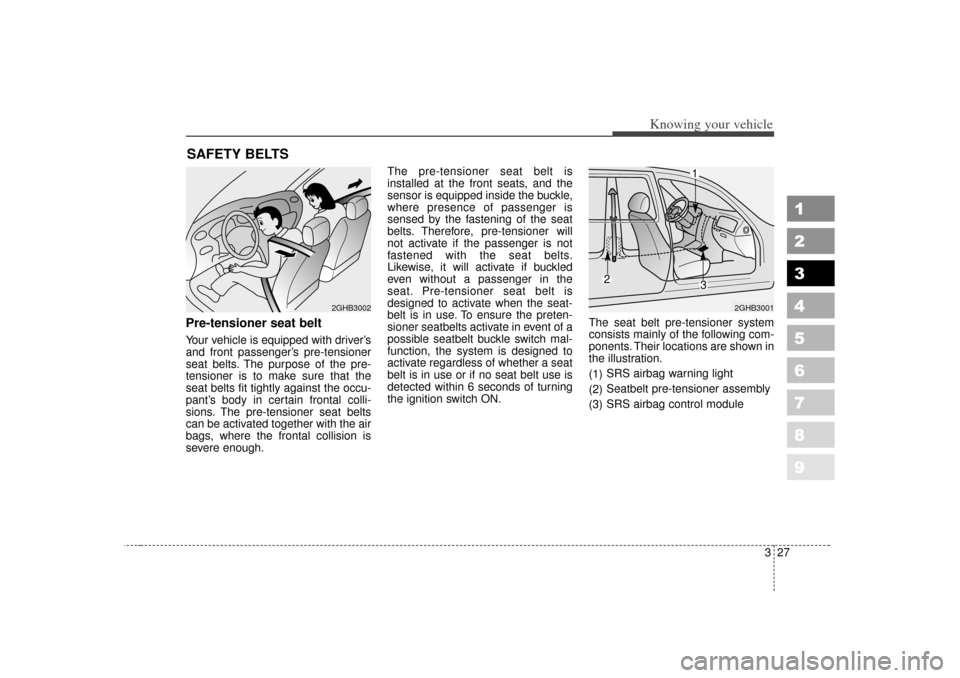
327
1
2
3
4
5
6
7
8
9
Knowing your vehicle
Pre-tensioner seat beltYour vehicle is equipped with driver’s
and front passenger’s pre-tensioner
seat belts. The purpose of the pre-
tensioner is to make sure that the
seat belts fit tightly against the occu-
pant’s body in certain frontal colli-
sions. The pre-tensioner seat belts
can be activated together with the air
bags, where the frontal collision is
severe enough.The pre-tensioner seat belt is
installed at the front seats, and the
sensor is equipped inside the buckle,
where presence of passenger is
sensed by the fastening of the seat
belts. Therefore, pre-tensioner will
not activate if the passenger is not
fastened with the seat belts.
Likewise, it will activate if buckled
even without a passenger in the
seat. Pre-tensioner seat belt is
designed to activate when the seat-
belt is in use. To ensure the preten-
sioner seatbelts activate in event of a
possible seatbelt buckle switch mal-
function, the system is designed to
activate regardless of whether a seat
belt is in use or if no seat belt use is
detected within 6 seconds of turning
the ignition switch ON.
The seat belt pre-tensioner system
consists mainly of the following com-
ponents. Their locations are shown in
the illustration.
(1)
SRS airbag warning light
(2) Seatbelt pre-tensioner assembly
(3) SRS airbag control moduleSAFETY BELTS
2GHB3002
2GHB3001
1
2
3
Page 38 of 300
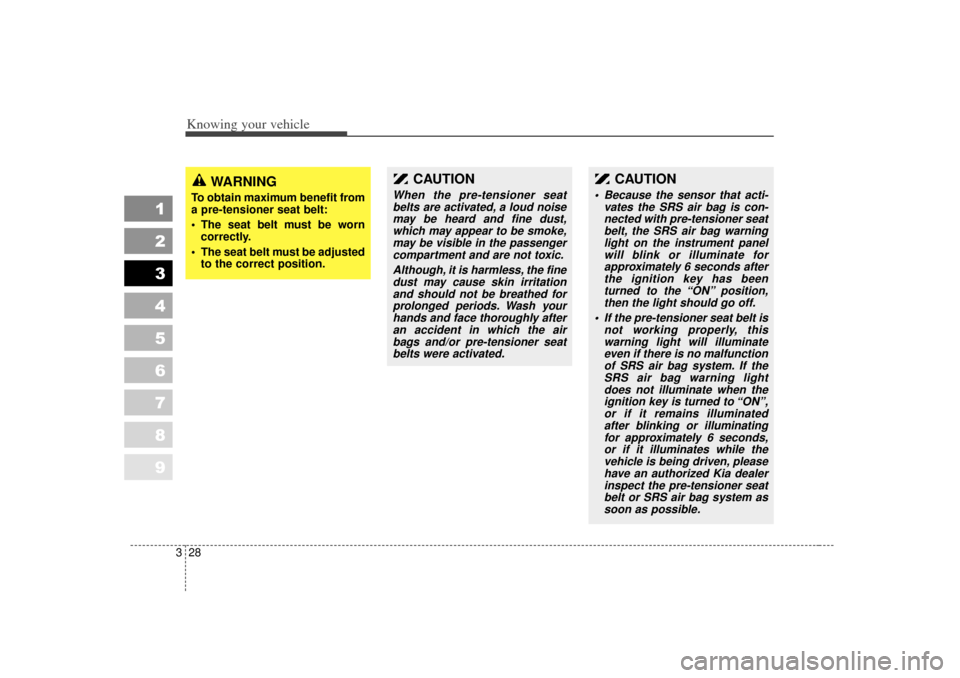
Knowing your vehicle28
3
1
2
3
4
5
6
7
8
9
WARNING
To obtain maximum benefit from
a pre-tensioner seat belt:
The seat belt must be worn
correctly.
The seat belt must be adjusted to the correct position.
CAUTION
When the pre-tensioner seatbelts are activated, a loud noisemay be heard and fine dust,which may appear to be smoke,may be visible in the passengercompartment and are not toxic.
Although, it is harmless, the finedust may cause skin irritationand should not be breathed forprolonged periods. Wash yourhands and face thoroughly afteran accident in which the airbags and/or pre-tensioner seatbelts were activated.
CAUTION
Because the sensor that acti- vates the SRS air bag is con-nected with pre-tensioner seatbelt, the SRS air bag warninglight on the instrument panelwill blink or illuminate forapproximately 6 seconds afterthe ignition key has beenturned to the “ON” position,then the light should go off.
If the pre-tensioner seat belt is not working properly, thiswarning light will illuminateeven if there is no malfunctionof SRS air bag system. If theSRS air bag warning lightdoes not illuminate when theignition key is turned to “ON”,or if it remains illuminatedafter blinking or illuminatingfor approximately 6 seconds,or if it illuminates while thevehicle is being driven, pleasehave an authorized Kia dealerinspect the pre-tensioner seatbelt or SRS air bag system assoon as possible.
Page 60 of 300

Knowing your vehicle50
3
1
2
3
4
5
6
7
8
9
AIR BAG - ADVANCED SUPPLEMENTAL RESTRAINT SYSTEM 1JBN3511A/OMGA035047/OMGA035048/OMGA035049/OMGA035051/OMGA035052/OMGA035\
053/OMGA035055/OMGA035054/1LDN2166/1LDN2167/1LDN21681
2
3
5
4
7
(1) Driver’ s air bag
(2) Front passenger ’s air bag
(3) Side air bag*
(4) Curtain air bag*
(5) SRS Control Module
(6) Side impact sensor*
(7) Front impact sensor
(8) Front seat position sensor
(9) Occupant classification system
* : if equipped
9
8
6
Page 63 of 300
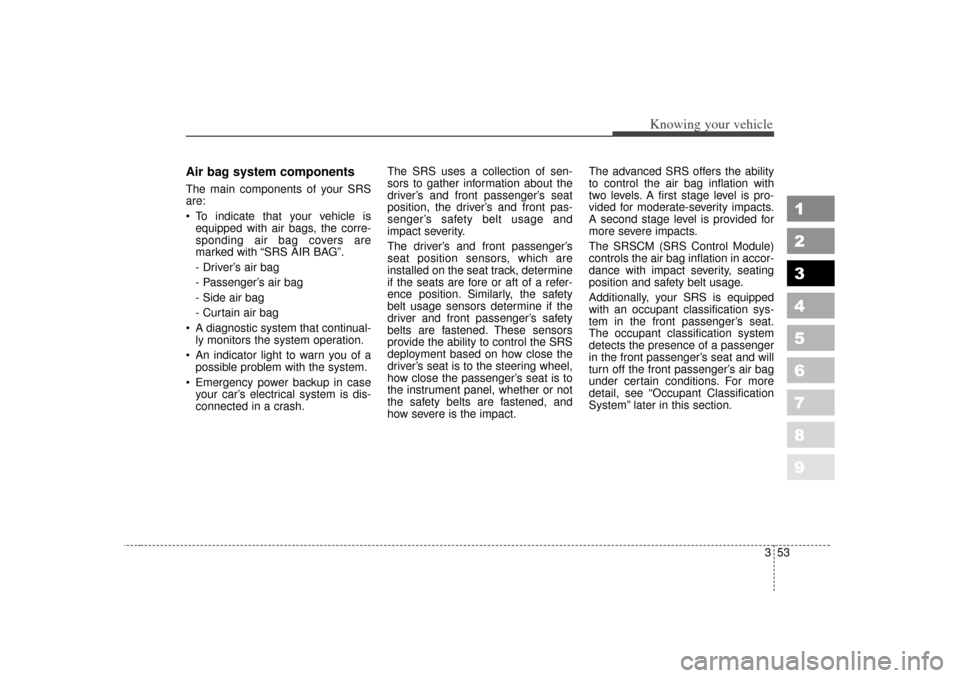
353
1
2
3
4
5
6
7
8
9
Knowing your vehicle
Air bag system components The main components of your SRS
are:
To indicate that your vehicle is
equipped with air bags, the corre-
sponding air bag covers are
marked with “SRS AIR BAG”.
- Driver’ s air bag
- Passenger’ s air bag
- Side air bag
- Curtain air bag
A diagnostic system that continual-
ly monitors the system operation.
An indicator light to warn you of a
possible problem with the system.
Emergency power backup in case
your car’ s electrical system is dis-
connected in a crash. The SRS uses a collection of sen-
sors to gather information about the
driver’
s and front passenger’ s seat
position, the driver’ s and front pas-
senger’ s safety belt usage and
impact severity.
The driver’ s and front passenger’ s
seat position sensors, which are
installed on the seat track, determine
if the seats are fore or aft of a refer-
ence position. Similarly, the safety
belt usage sensors determine if the
driver and front passenger’ s safety
belts are fastened. These sensors
provide the ability to control the SRS
deployment based on how close the
driver’ s seat is to the steering wheel,
how close the passenger’ s seat is to
the instrument panel, whether or not
the safety belts are fastened, and
how severe is the impact. The advanced SRS offers the ability
to control the air bag inflation with
two levels. A first stage level is pro-
vided for moderate-severity impacts.
A second stage level is provided for
more severe impacts.
The SRSCM (SRS Control Module)
controls the air bag inflation in accor-
dance with impact severity, seating
position and safety belt usage.
Additionally, your SRS is equipped
with an occupant classification sys-
tem in the front passenger’
s seat.
The occupant classification system
detects the presence of a passenger
in the front passenger’ s seat and will
turn off the front passenger ’s air bag
under certain conditions. For more
detail, see “Occupant Classification
System” later in this section.
Page 64 of 300
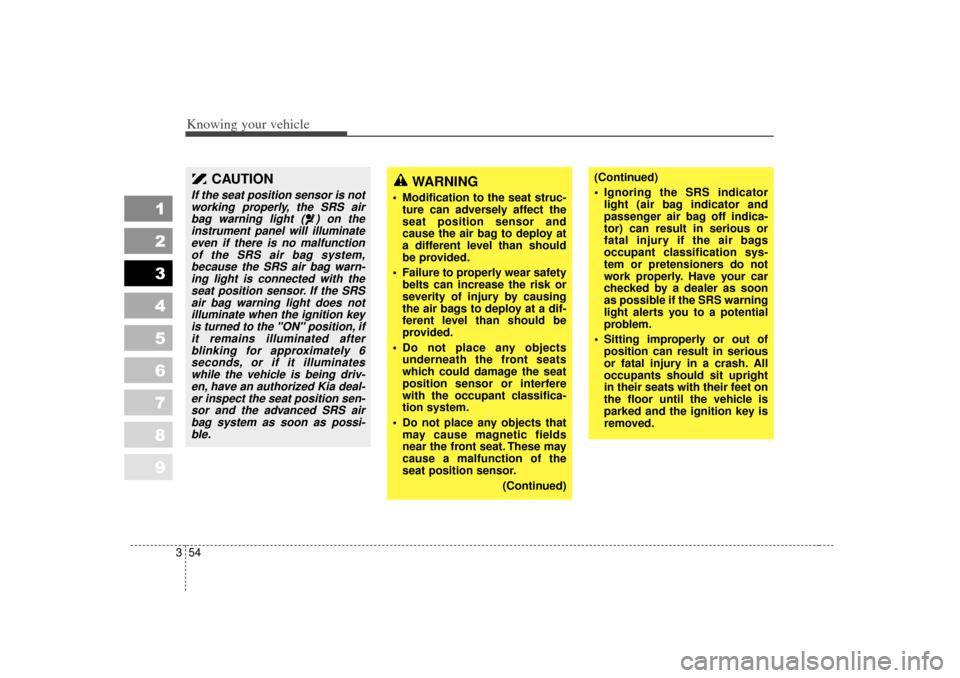
Knowing your vehicle54
3
1
2
3
4
5
6
7
8
9
CAUTION
If the seat position sensor is not
working properly, the SRS airbag warning light ( ) on theinstrument panel will illuminateeven if there is no malfunctionof the SRS air bag system,because the SRS air bag warn-ing light is connected with theseat position sensor. If the SRSair bag warning light does notilluminate when the ignition keyis turned to the "ON" position, ifit remains illuminated afterblinking for approximately 6seconds, or if it illuminateswhile the vehicle is being driv-en, have an authorized Kia deal-er inspect the seat position sen-sor and the advanced SRS airbag system as soon as possi-ble.
WARNING
Modification to the seat struc- ture can adversely affect the
seat position sensor and
cause the air bag to deploy at
a different level than should
be provided.
Failure to properly wear safety belts can increase the risk or
severity of injury by causing
the air bags to deploy at a dif-
ferent level than should be
provided.
Do not place any objects underneath the front seats
which could damage the seat
position sensor or interfere
with the occupant classifica-
tion system.
Do not place any objects that may cause magnetic fields
near the front seat. These may
cause a malfunction of the
seat position sensor.
(Continued)
(Continued)
Ignoring the SRS indicatorlight (air bag indicator and
passenger air bag off indica-
tor) can result in serious or
fatal injury if the air bags
occupant classification sys-
tem or pretensioners do not
work properly. Have your car
checked by a dealer as soon
as possible if the SRS warning
light alerts you to a potential
problem.
Sitting improperly or out of position can result in serious
or fatal injury in a crash. All
occupants should sit upright
in their seats with their feet on
the floor until the vehicle is
parked and the ignition key is
removed.
Page 71 of 300
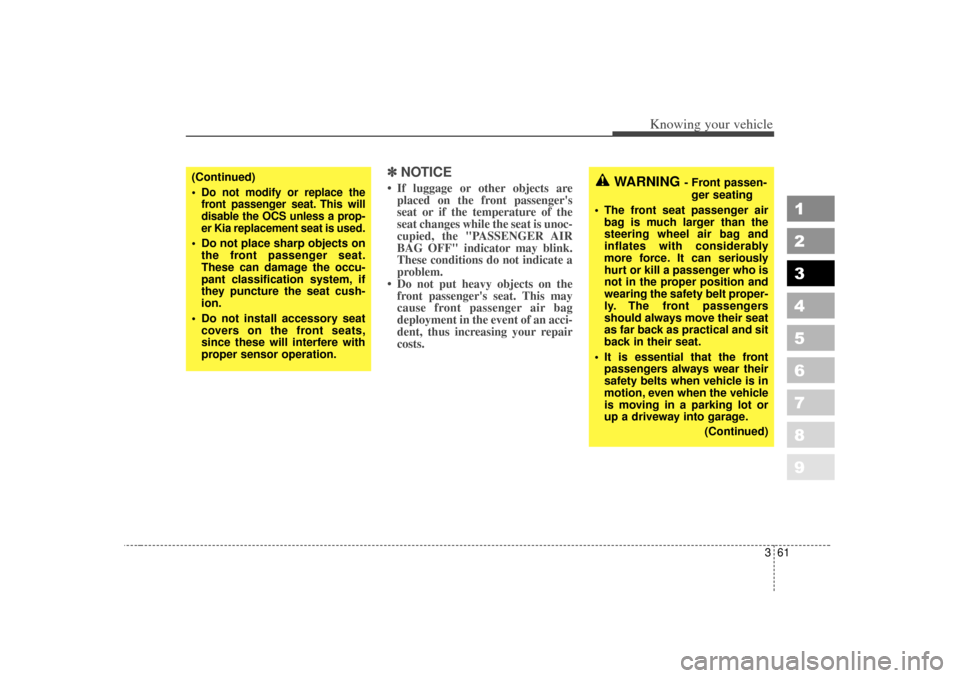
361
1
2
3
4
5
6
7
8
9
Knowing your vehicle
✽ ✽NOTICE• If luggage or other objects are
placed on the front passenger's
seat or if the temperature of the
seat changes while the seat is unoc-
cupied, the "PASSENGER AIR
BAG OFF" indicator may blink.
These conditions do not indicate a
problem.
• Do not put heavy objects on the front passenger's seat. This may
cause front passenger air bag
deployment in the event of an acci-
dent, thus increasing your repair
costs.
WARNING
- Front passen-
ger seating
The front seat passenger air bag is much larger than the
steering wheel air bag and
inflates with considerably
more force. It can seriously
hurt or kill a passenger who is
not in the proper position and
wearing the safety belt proper-
ly. The front passengers
should always move their seat
as far back as practical and sit
back in their seat.
It is essential that the front passengers always wear their
safety belts when vehicle is in
motion, even when the vehicle
is moving in a parking lot or
up a driveway into garage.
(Continued)
(Continued)
Do not modify or replace the
front passenger seat. This will
disable the OCS unless a prop-
er Kia replacement seat is used. Do not place sharp objects onthe front passenger seat.
These can damage the occu-
pant classification system, if
they puncture the seat cush-
ion.
Do not install accessory seat covers on the front seats,
since these will interfere with
proper sensor operation.
Page 75 of 300

365
1
2
3
4
5
6
7
8
9
Knowing your vehicle
Why didn’t my air bag go off in
a collision? (Inflation and non-inflation condi-tions of the air bag)There are many types of accidents in
which the air bag would not be
expected to provide additional pro-
tection.
These include rear impacts, second
or third collisions in multiple impact
accidents, as well as low speed
impacts. In other words, just because
your vehicle is damaged and even if
it is totally unusable, don’t be sur-
prised that the air bags did not
inflate.
1JBA3512A/OMG035052/OMG035054/OMG035053/OMG035055
1
2
3
Air bag collision sensors(1) SRS control module
(2) Front impact sensor (3)
Side impact sensor (if equipped)
Page 76 of 300
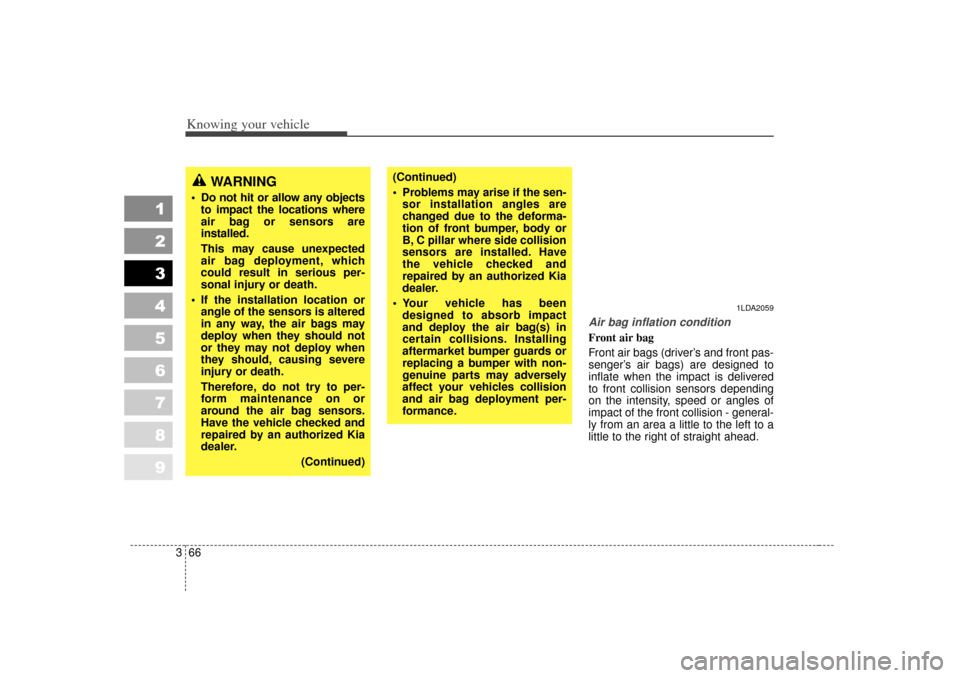
Knowing your vehicle66
3
1
2
3
4
5
6
7
8
9
Air bag inflation conditionFront air bag
Front air bags (driver ’s and front pas-
senger’ s air bags) are designed to
inflate when the impact is delivered
to front collision sensors depending
on the intensity, speed or angles of
impact of the front collision - general-
ly from an area a little to the left to a
little to the right of straight ahead.
WARNING
Do not hit or allow any objects to impact the locations where
air bag or sensors are
installed.
This may cause unexpected
air bag deployment, which
could result in serious per-
sonal injury or death.
If the installation location or angle of the sensors is altered
in any way, the air bags may
deploy when they should not
or they may not deploy when
they should, causing severe
injury or death.
Therefore, do not try to per-
form maintenance on or
around the air bag sensors.
Have the vehicle checked and
repaired by an authorized Kia
dealer.
(Continued)
(Continued)
Problems may arise if the sen-sor installation angles are
changed due to the deforma-
tion of front bumper, body or
B, C pillar where side collision
sensors are installed. Have
the vehicle checked and
repaired by an authorized Kia
dealer.
Your vehicle has been designed to absorb impact
and deploy the air bag(s) in
certain collisions. Installing
aftermarket bumper guards or
replacing a bumper with non-
genuine parts may adversely
affect your vehicles collision
and air bag deployment per-
formance.
1LDA2059
Page 77 of 300

367
1
2
3
4
5
6
7
8
9
Knowing your vehicle
Side air bag (if equipped)
Side air bags (side and curtain air
bags) are designed to inflate when
an impact is detected by side colli-
sion sensors depending on the
strength, speed or angles of impact
of side impact collision or rollover by
the side impact.Although the front air bags (driver
’s
and front passenger’ s air bags) are
designed to inflate only in frontal col-
lision, it may inflate in any collision if
front impact sensors detect a suffi-
cient impact. Side air bags (side and
curtain air bags) are designed to
inflate only in side impact collision, it
may inflate in any collision if side
impact sensors detect a sufficient
impact. If the vehicle chassis is impacted by
bumps or objects on unimproved
roads or sidewalks, air bags may
deploy. Drive carefully on unim-
proved roads or on surfaces not
designed for vehicle traffic.
To protect occupants, front air bags
or pre-tensioner safety belts may
deploy in certain side impact colli-
sions.
1JBA3514OUN026090
Page 80 of 300
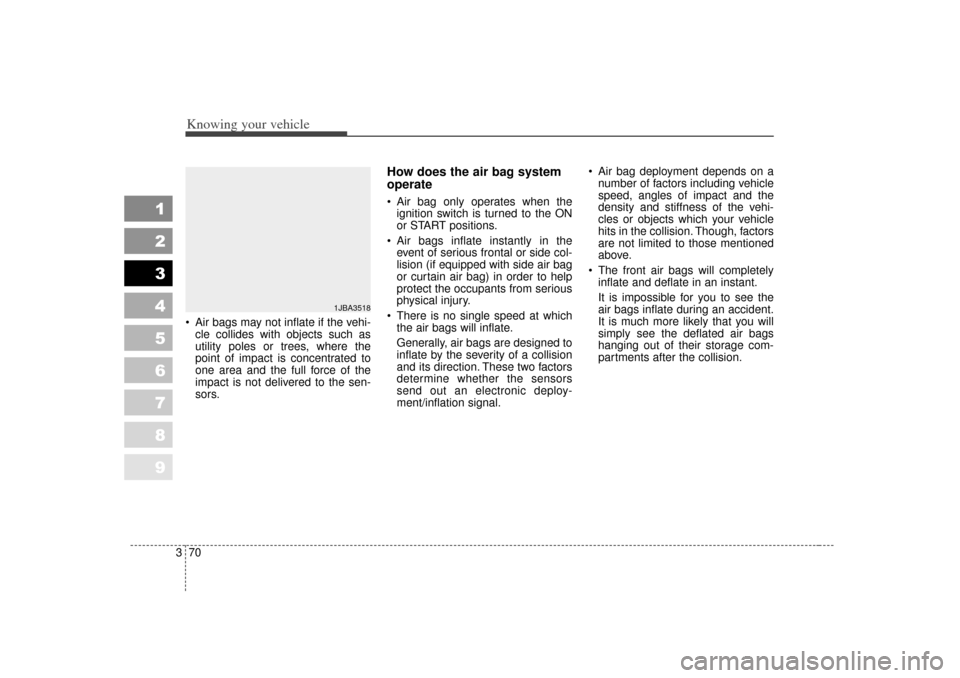
Knowing your vehicle70
3
1
2
3
4
5
6
7
8
9
Air bags may not inflate if the vehi-
cle collides with objects such as
utility poles or trees, where the
point of impact is concentrated to
one area and the full force of the
impact is not delivered to the sen-
sors.
How does the air bag system
operate Air bag only operates when the
ignition switch is turned to the ON
or START positions.
Air bags inflate instantly in the
event of serious frontal or side col-
lision (if equipped with side air bag
or curtain air bag) in order to help
protect the occupants from serious
physical injury.
There is no single speed at which
the air bags will inflate.
Generally, air bags are designed to
inflate by the severity of a collision
and its direction. These two factors
determine whether the sensors
send out an electronic deploy-
ment/inflation signal.
Air bag deployment depends on a
number of factors including vehicle
speed, angles of impact and the
density and stiffness of the vehi-
cles or objects which your vehicle
hits in the collision. Though, factors
are not limited to those mentioned
above.
The front air bags will completely
inflate and deflate in an instant.
It is impossible for you to see the
air bags inflate during an accident.
It is much more likely that you will
simply see the deflated air bags
hanging out of their storage com-
partments after the collision.
1JBA3518